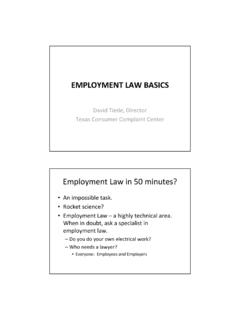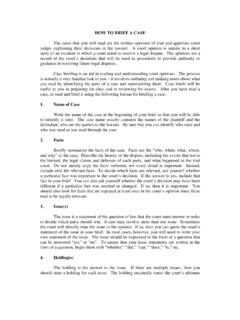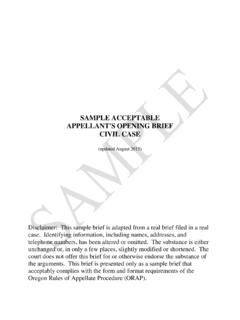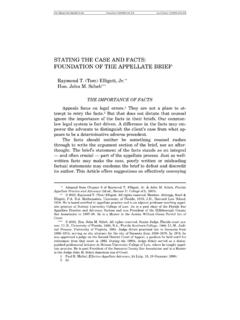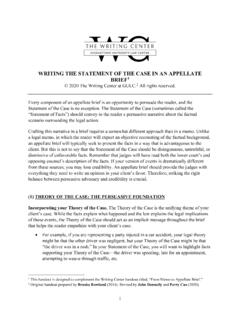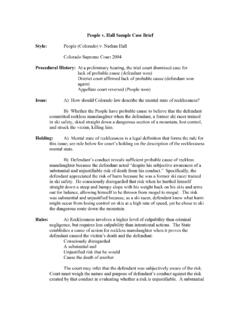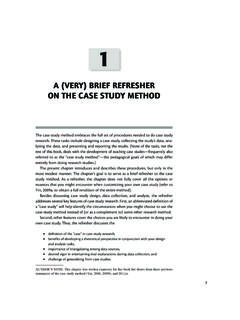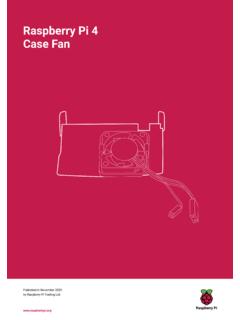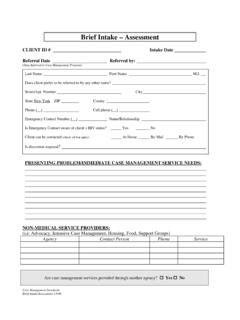Transcription of orientation case brief - University of Houston Law Center
1 HOW TO brief A case I. Distinctions A. A case brief is a dissection of a judicial opinion -- it contains a written summary of the basic components of that decision. B. Persuasive briefs (trial and appellate) are the formal documents a lawyer files with a court in support of his or her client s position. II. Functions of case briefing A. case briefing helps you acquire the skills of case analysis and legal reasoning. Briefing a case helps you understand it. B. case briefing aids your memory. Briefs help you remember the cases you read (1) for class discussion, (2) for end-of-semester review for final examinations, and (3) for writing and analyzing legal problems. Do not try to memorize case briefs. Learning law is a process of problem solving through legal reasoning.
2 Cases must be read in light of the series of cases with which they appear in your casebook or on the class syllabus. III. Briefing a case : The steps Although the exact form of your briefs may and can vary from case to case , the following parts should appear somewhere in your brief in a way that helps you understand the case and recall the needed information. 1. Read through the opinion first so you will understand the overall story and identify important facts, etc., before beginning to brief the case on paper. 2. Heading: a. case name (to identify the parties) b. Court name c. Date of the decision d. Page number where the case appears in the textbook 3. Statement of Facts a. Identify the relationship/status of the parties (Note: Do not merely refer to the parties as the plaintiff/defendant or appellant/appellee; be sure to also include more descriptive generic terms to identify the relationship/status at issue, , buyer/seller, employer/employee, landlord/tenant, etc.)
3 B. Identify legally relevant facts, that is, those facts that tend to prove or disprove an issue before the court. The relevant facts tell what happened before the parties entered the judicial system. c. Identify procedurally significant facts. You should set out (1) the cause of action (C/A) (the law the plaintiff claimed was broken), (2) relief the plaintiff requested, (3) defenses, if any, the defendant raised. 4. Procedural History (PH): This is the disposition of the case in the lower court(s) that explains how the case got to the court whose opinion you are reading. Include the following: a. The decision(s) of the lower court(s). NOTE: If the case was decided by a trial court and reviewed by an intermediate appellate court before reaching the court whose decision you are now reading, be sure to note what each court decided.
4 B. The damages awarded, if relevant. c. Who appealed and why. 5. Issues: a. Substantive issue: A substantive statement of the issue consists of two parts -- i. the point of law in dispute ii. the key facts of the case relating to that point of law in dispute (legally relevant facts) You must include the key facts from the case so that the issue is specific to that case . Typically, the disputed issue involves how the court applied some element of the pertinent rule to the facts of the specific case . Resolving the issue will determine the court s disposition of the case . b. Procedural issue: What is the appealing party claiming the lower court did wrong ( , ruling on evidence, jury instructions, granting of summary judgment, etc.)
5 ? 6. Judgment: This is the court s final decision as to the rights of the parties, the court s response to a party s request for relief. Generally, the appellate court will either affirm, reverse, or reverse with instructions. The judgment is usually found at the end of the opinion. 7. Holding: This is a statement of law that is the court s answer to the issue. If you have written the issue statement(s) correctly, the holding is often the positive or negative statement of the issue statement. 8. Rule of Law or Legal Principle Applied: This is the rule of law that the court applies to determine the substantive rights of the parties. The rule of law could derive from a statute, case rule, regulation, or may be a synthesis of prior holdings in similar cases (common law).
6 The rule or legal principle may be expressly stated in the opinion or it may be implied. 9. Reasoning: This is the court s analysis of the issues and the heart of the case brief . Reasoning is the way in which the court applied the rules/ legal principles to the particular facts in the case to reach its decision. This includes syllogistic application of rules as well as policy arguments the court used to justify its holding (why the decision was socially desirable). 10. Concurring/Dissenting Opinions: A judge who hears a case may not agree with the majority s decision and will write a separate dissenting opinion. Another judge may agree with the decision but not with the majority s reasoning and will write a separate concurring opinion. Note the concurring/dissenting judge(s) reasons for refusing to join in the majority opinion.
7 11. Additional Comments/Personal Impressions: What are your reactions to and critique of the opinion? Anything you like? Dislike? How does this case fall in line with the other cases you have read? Do not accept the court s opinion blindly. Assess the reasoning in each case . Is it sound? Is it contradictory? What are the political, economic or social impacts of this decision? * * * * *





